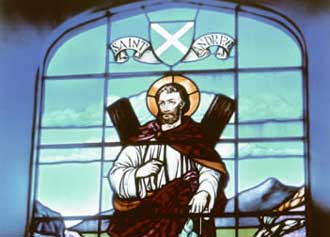|
谁是苏格兰的守护神?
[ 2007-07-13 10:29 ]
圣安德鲁(St Andrew)是苏格兰的守护神,同时也是希腊、俄罗斯和罗马尼亚的守护神。作为圣彼得的兄弟和最初的使徒之一,安德鲁据说是在希腊的佩特雷(Patras) 被杀害的,他向判处他死刑的罗马当局请求,不要让他采用和耶稣一样的姿势在十字架上钉死。他的请求得到批准,于是他最终是在X形的十字架上(圣安德鲁十字或X形十字)被处死的,所以X形十字后来也就成为了他的象征。
 St Andrew is the patron saint of Scotland, a task he shares with Greece, Russia and Romania. The brother of St Peter and one of the original Apostles, Andrew was reputedly martyred at Patras in Greece, having petitioned the Roman authorities who had sentenced him to death not to crucify him on the same shape of cross as Christ. His request was granted and Andrew was duly crucified on the x-shaped cross (or saltire) which has subsequently become his symbol. St Andrew is the patron saint of Scotland, a task he shares with Greece, Russia and Romania. The brother of St Peter and one of the original Apostles, Andrew was reputedly martyred at Patras in Greece, having petitioned the Roman authorities who had sentenced him to death not to crucify him on the same shape of cross as Christ. His request was granted and Andrew was duly crucified on the x-shaped cross (or saltire) which has subsequently become his symbol.
St Andrew and Scotland
His association with Scotland traditionally stems from either of two legendary sources. Relics of the saint were reputedly brought from Patras to Kinrymont in Fife in the 4th century by St Regulus, following his shipwrecking off the east coast. The church at Kinrymont subsequently became the cathedral of St Andrews and developed into a major centre of medieval pilgrimage. Another version relates that in the 9th century, the Pictish king, Angus mac Fergus adopted St Andrew as patron following the appearance of a saltire in the sky immediately before his victory at Athelstaneford.
Saints and Symbols
Records show that St Andrew was probably the patron of Scotland by the year 1000. In 1286, the Seal of the Guardians of Scotland bore, on the obverse, a representation of St Andrew on his x-shaped cross, with the Latin inscription Andrea Scotis Dux Eesto Compatriotis - 'St Andrew be leader of the compatriot Scots'. In I390, St Andrew was first used as a national symbol on a coin of the realm, a five-shilling piece minted in the reign of Robert III.
St Andrew's Day, 30 November, is not a public holiday in Scotland.
本频道更多精彩内容
|